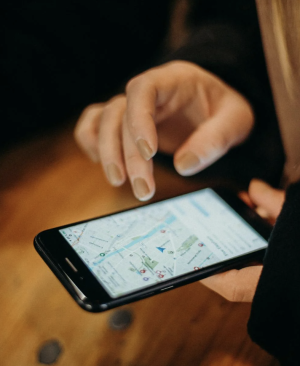Should you blur your house on Google Maps? Here’s why more people are doing it
By
Veronica E.
- Replies 0
Our homes used to be private spaces—places only our neighbors or mail carriers would see.
But now, thanks to tools like Google Maps’ Street View, anyone around the world can virtually “walk by” your house.
While it might seem harmless or even convenient, more and more everyday people—not just celebrities—are choosing to blur their homes for privacy and peace of mind.
And as it turns out, it’s easier than you might think.
Why some folks are choosing to blur their homes
You don’t have to be rich or famous to want a little privacy.
For retirees, grandparents, or anyone who simply values their home as a sanctuary, blurring your house from view can help reduce unwanted exposure.
Why? Street View images can reveal quite a bit more than just what color your door is.

Your car’s make and model, your security cameras—or lack of them—and even your home’s layout may be visible to people who don’t need that information.
Some law enforcement officials warn that criminals often use digital tools to scout out homes before ever setting foot on the property.
As Officer Ryan Railsback of the Riverside Police Department in California shared: “The crooks are looking for new and innovative ways to victimize people. It’s good for the public to be aware of that and counter what the criminals are already doing.”
Could blurring make you a target? Some experts weigh in
Of course, no safety measure is perfect. Some privacy experts point out that if you’re the only person on your street with a blurred house, it might actually raise curiosity or unwanted attention.
Professor Christopher Herrmann from John Jay College of Criminal Justice told reporters: “It may be more of a red flag.”
So, is it better to blur or not? That depends on your comfort level, your neighborhood, and how visible you are already online.
Also read: 10,000 lies and a lawsuit—Google takes action against scammers
How to blur your home on Google Maps
If you decide to go ahead with it, the process is surprisingly simple. Here’s how you can do it in just a few steps:
One important note: once your home is blurred, it’s permanent. Google doesn’t offer an option to reverse it, so be sure it’s the right decision for you before submitting.
Also read: Alert: The $2,000 Google Maps scam putting your home at risk
What does Google say about all this?
Google already blurs faces and license plates automatically in Street View, and their privacy policy states: “We have developed cutting-edge face and license plate blurring technology that is designed to blur identifiable faces and license plates within Google-contributed imagery in Street View.”
However, if you notice something personal in the image—like your child playing in the yard or your car clearly showing identifying details—you can request extra blurring any time using the same “Report a problem” feature.
Also read: Texas woman’s historic family land stolen and sold for $45K—how it happened and how to protect yours
Pros and cons: is blurring right for you?
Like many privacy options, this one has upsides and trade-offs. Here’s a quick look:
Pros
Cons
Also read: Gmail’s game-changing move to tackle spam—say goodbye to junk mail!
What people are saying online
This issue has been discussed on forums, where users have shared their experiences—especially after crimes or break-ins in their neighborhoods.
One commenter said: “Not everybody likes to see you doing nice in life. We live in a world of people wanting five-finger discounts. If thieves have an option to look at a house without even being there, I 100% don’t want to be a part of that.”
Another user mentioned that after some thefts near their farm, they decided to blur their house, just to feel a bit safer.
Still, some people prefer not to blur, feeling it draws more attention or that it breaks the sense of openness in a neighborhood.
Also read: These residents were unknowingly paying for someone else’s bills… Are YOU in the same boat?
Other ways to protect your digital footprint at home
Blurring your house is a good start, but it isn’t the only way to stay safe. Here are some other ways to protect your home and family online:
Whether you choose to blur your home or not, the key is staying informed and making the privacy choices that feel right for you.
In a world where technology moves fast, even small steps—like this one—can help you feel more secure and in control.
Read next: The Truth About World Maps

Have you blurred your home on Google Maps—or thought about it? Do you feel safer, or have you noticed any changes in how people interact with your property? Or do you think it’s all just digital overkill?
We’d love to hear your thoughts. Whether you’ve taken this step or decided against it, your perspective can help others decide what’s best for them in this increasingly digital world.
But now, thanks to tools like Google Maps’ Street View, anyone around the world can virtually “walk by” your house.
While it might seem harmless or even convenient, more and more everyday people—not just celebrities—are choosing to blur their homes for privacy and peace of mind.
And as it turns out, it’s easier than you might think.
Why some folks are choosing to blur their homes
You don’t have to be rich or famous to want a little privacy.
For retirees, grandparents, or anyone who simply values their home as a sanctuary, blurring your house from view can help reduce unwanted exposure.
Why? Street View images can reveal quite a bit more than just what color your door is.

A growing number of homeowners are choosing to blur their houses on Google Maps to reclaim a sense of privacy in today’s digital world. Image Source: Pexels / cottonbro studio.
Your car’s make and model, your security cameras—or lack of them—and even your home’s layout may be visible to people who don’t need that information.
Some law enforcement officials warn that criminals often use digital tools to scout out homes before ever setting foot on the property.
As Officer Ryan Railsback of the Riverside Police Department in California shared: “The crooks are looking for new and innovative ways to victimize people. It’s good for the public to be aware of that and counter what the criminals are already doing.”
Could blurring make you a target? Some experts weigh in
Of course, no safety measure is perfect. Some privacy experts point out that if you’re the only person on your street with a blurred house, it might actually raise curiosity or unwanted attention.
Professor Christopher Herrmann from John Jay College of Criminal Justice told reporters: “It may be more of a red flag.”
So, is it better to blur or not? That depends on your comfort level, your neighborhood, and how visible you are already online.
Also read: 10,000 lies and a lawsuit—Google takes action against scammers
How to blur your home on Google Maps
If you decide to go ahead with it, the process is surprisingly simple. Here’s how you can do it in just a few steps:
- Open Google Maps and enter your home address
- Switch to Street View using the little yellow person icon
- Find your house in the image
- Click “Report a problem” in the lower right corner
- Select “Request blurring” and choose “My home”
- Drag the red box to cover your entire home, garage, or any other structures
- Enter your email address for confirmation
- Submit and wait for a response from Google
One important note: once your home is blurred, it’s permanent. Google doesn’t offer an option to reverse it, so be sure it’s the right decision for you before submitting.
Also read: Alert: The $2,000 Google Maps scam putting your home at risk
What does Google say about all this?
Google already blurs faces and license plates automatically in Street View, and their privacy policy states: “We have developed cutting-edge face and license plate blurring technology that is designed to blur identifiable faces and license plates within Google-contributed imagery in Street View.”
However, if you notice something personal in the image—like your child playing in the yard or your car clearly showing identifying details—you can request extra blurring any time using the same “Report a problem” feature.
Also read: Texas woman’s historic family land stolen and sold for $45K—how it happened and how to protect yours
Pros and cons: is blurring right for you?
Like many privacy options, this one has upsides and trade-offs. Here’s a quick look:
Pros
- Offers extra privacy by removing your home’s image from easy public view
- May discourage criminals from virtually “scoping out” your property
- Adds peace of mind for those concerned about digital exposure
Cons
- Might draw curiosity if you’re the only blurred house on your block
- The blur is permanent and cannot be undone
- Doesn’t guarantee full privacy—people can still view older or third-party images elsewhere
Also read: Gmail’s game-changing move to tackle spam—say goodbye to junk mail!
What people are saying online
This issue has been discussed on forums, where users have shared their experiences—especially after crimes or break-ins in their neighborhoods.
One commenter said: “Not everybody likes to see you doing nice in life. We live in a world of people wanting five-finger discounts. If thieves have an option to look at a house without even being there, I 100% don’t want to be a part of that.”
Another user mentioned that after some thefts near their farm, they decided to blur their house, just to feel a bit safer.
Still, some people prefer not to blur, feeling it draws more attention or that it breaks the sense of openness in a neighborhood.
Also read: These residents were unknowingly paying for someone else’s bills… Are YOU in the same boat?
Other ways to protect your digital footprint at home
Blurring your house is a good start, but it isn’t the only way to stay safe. Here are some other ways to protect your home and family online:
- Check your social media settings. Avoid posting anything that reveals your address or inside views of your home
- Review your home’s visibility on other mapping services, like Apple Maps or Bing Maps
- Secure your Wi-Fi network with a strong password
- Use visible security tools like motion lights, cameras, or alarm signs—even decoys can help
Whether you choose to blur your home or not, the key is staying informed and making the privacy choices that feel right for you.
In a world where technology moves fast, even small steps—like this one—can help you feel more secure and in control.
Read next: The Truth About World Maps
Key Takeaways
- You can easily request to have your house blurred on Google Maps to improve your privacy, using the ‘report a problem’ feature on the Maps app.
- Blurring your home can help deter would-be thieves from checking out your property’s valuables or security measures online.
- Some experts warn that blurring your house could also attract attention, as it may make criminals wonder what you’re trying to hide if yours is the only blurred home on the street.
- The option to blur not only your home but also cars, faces, and other personal features is available to anyone—not just celebrities or public figures—helping to protect your privacy on Street View.
Have you blurred your home on Google Maps—or thought about it? Do you feel safer, or have you noticed any changes in how people interact with your property? Or do you think it’s all just digital overkill?
We’d love to hear your thoughts. Whether you’ve taken this step or decided against it, your perspective can help others decide what’s best for them in this increasingly digital world.






